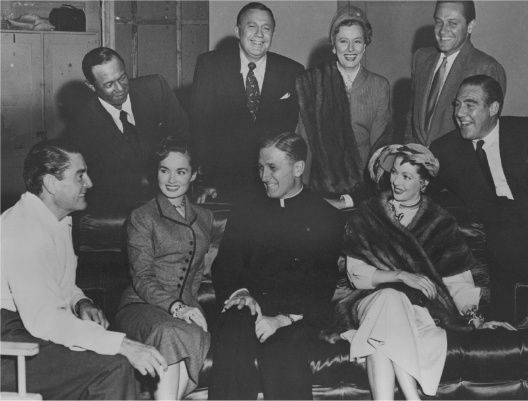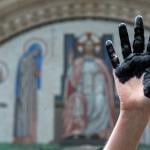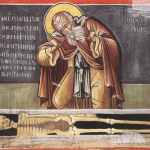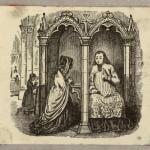Earlier I posted a picture of celebrities from the 1940s and asked you to identify them.
Some of the guesses were very good, indeed. I myself was only able to recognize Loretta Young (the sitting gal with the feathered hat) but I got waylaid by the fellow in profile, who looked a little like Cary Grant, if Cary Grant had looked like that.
Let’s look again:

The un-Cary Grant is the film director Leo McCarey. The back row is Eddie “Rochester” Anderson, Jack Benny, Irene Dunne, and William Holden. The front row is Leo McCarey, Ann Blyth, a priest, Loretta Young, and on the armrest Paul Douglas.
Why did I show you the picture?
Well, let’s look at that priest, again. This time, with James Cagney!

That priest is a man worth knowing about, because he was eloquent in proclaiming “The Cure for Which Mankind Longs”. His name was Fr. James Keller, and he resisted the priesthood:
One day, a priest named Father Ryan came into the store to buy something and Keller started discussing his decision to leave the seminary, seeming to want confirmation that he had done the right thing. But Father Ryan told him, “I’m not going to take it on my conscience to tell you not to go back to the seminary. After all, in God’s plan, there may be thousands of people whose salvation depends on what you may do for them as a priest.”
In his autobiography, Father Keller wrote, “I began to see that failure on my part to be an instrument of the divine plan could, in a minor way at least, deprive others of blessings that rightfully belonged to them and that were to be sent through one person like myself.” This notion that we each have a particular mission to fulfill in life became an integral part of Father Keller’s philosophy.
An important message for all of us. Then there is this:
Another pivotal moment for Father Keller came during a meeting at New York’s Metropolitan Opera House during which he entered the completely darkened auditorium and couldn’t see a thing. The person he was with lit a match and set off to find the light switch. Father Keller recalled, “The sight of that tiny flame made an indelible impression on me. Insignificant as it was, it was greater than the darkness. All that was needed to banish the darkness completely was to multiply that flicker of light.”
That’s exactly what Father Keller set out to do when he founded the Christopher movement in 1945. He chose the name The Christophers because it means “Christ-bearer” in Greek, and adopted as the movement’s motto the old Chinese proverb, “It’s better to light one candle than to curse the darkness.”
Though some people initially saw The Christophers as an anti-communist organization, Father Keller was quick to point out that his central goal was not to be against something bad, but rather to support something good. He said, “One of the best ways to cure a starving patient is to build him up with nourishing food; the best way to cure this disease in our society is to build up society itself with good ideas and ideals.”
Keller’s work and philosophy seem to be particularly well-suited to our times, and Tony Rossi’s brief exposition of the man and his legacy is a read that informs the mind and feeds the soul. I hope you’ll read it. You’ll be glad, and perhaps even inspired.
Related:
The Stuff Our Priests are Made Of











